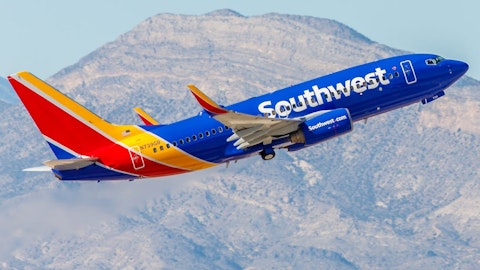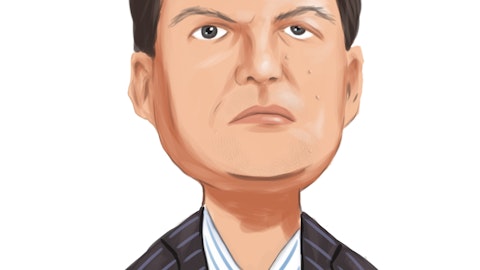SkyWest, Inc. (NASDAQ:SKYW) Q4 2023 Earnings Call Transcript February 1, 2024
SkyWest, Inc. beats earnings expectations. Reported EPS is $0.4193, expectations were $0.11. SkyWest, Inc. isn’t one of the 30 most popular stocks among hedge funds at the end of the third quarter (see the details here).
Operator: Hello, and thank you for standing by. My name is Regina, and I will be your conference operator today. At this time, I would like to welcome everyone to the SkyWest Inc. Fourth Quarter and Full Year 2023 Earnings Results Conference Call. [Operator Instructions] I would now like to turn the conference over to Rob Simmons, Chief Financial Officer. Please go ahead.
Rob Simmons: Thank you, Regina, and thanks everyone for joining us on the call today. As the operator indicated, this is Rob Simmons, SkyWest’s Chief Financial Officer. On the call with me today are Chip Childs, President and Chief Executive Officer; Wade Steel, Chief Commercial Officer; and Eric Woodward, Chief Accounting Officer. I’d like to start today by asking Eric to read the safe harbor, then I will turn the time over to Chip for some comments. Following Chip, I will take us through the financial results and Wade will discuss the fleet and related flying arrangements. Following Wade, we will have the customary Q&A session with our sell-side analysts. Eric?
Eric Woodward: Today’s discussion contains forward-looking statements that represent our current beliefs, expectations and assumptions regarding future events and are subject to risks and uncertainties. We assume no obligation to update any forward-looking statement, whether as a result of new information, future events or otherwise. Actual results will likely vary and may vary materially from those anticipated, estimated or projected for a number of reasons. Some of the factors that may cause such differences are included in our 2022 Form 10-K and other reports and filings with the Securities and Exchange Commission. And now, I’ll turn the call over to Chip.
Chip Childs: Thank you, Rob and Eric, and good afternoon, everyone. Thank you for joining us on the call again today. Today, I will recap our fourth quarter and full year 2023. Throughout the year, we executed on our business objectives to first and foremost take care of our people, to deliver on our partner commitments, and to maximize our risk as we optimize our capital deployment. Our unique model of collaborating with our people enables us to rapidly respond to both challenge and opportunity as well as deliver the best product in the regional industry. We believe this unique collaborative approach not only benefits our people and our product, it’s been a fundamental part of our success for over 52 years and will continue to help the SkyWest team lead the industry forward in 2024 and beyond.
I’m very proud to share that in 2023 SkyWest teams delivered a historic 300 days of 100% adjusted completion, besting our last annual completion record by over 100 days. Safely and reliably connecting people with global access via our four major partners is the business of our product, and we’re proud to do it better than anyone else in our space. This extraordinary achievement takes significant planning, preparation, and teamwork, and I want to thank our nearly 14,000 people, who worked together to provide an exceptional product to 38 million passengers last year alone. Today SkyWest reported net income of $18 million or $0.42 per diluted share for the fourth quarter of 2023 and full year 2023 net income of $34 million or $0.77 per diluted share.
Overall, our partnerships are strong and demand for our product remains extremely high. While 2023 was a little bumpy. We’re pleased with the performance and our expectations for production and profit are improved since our estimates last quarter. As shared last quarter, captain attrition has begun to improve and the fourth quarter showed the lowest attrition we’ve experienced in two years. With industry wide hiring also seeming to stabilize, we expect continued progress in 2024. As we all know, captain development takes extensive time and it will still be years to fully restore our crew balance and production. As I mentioned earlier, we are continually looking for ways to best take care of our people. Through ongoing investment and enhanced compensation packages over the past couple of years as well as improved opportunities for those who are looking to transition to mainline.
We recognize that pilots have more options than ever before and appreciate that they are recognizing the value proposition at SkyWest. In Q4, we announced a new pilot program with United exclusively for SkyWest pilots. This program provides a clear path to United early in SkyWest pilot career with a conditional offer from United at 400 hours for those accepted. This innovative program benefits both our pilots who want to transition to United as well as those who want to build a successful career at SkyWest by ensuring that those in the program contribute flying through SkyWest captain requirements. Shifting gears, we recently completed the acquisition of a 25% stake of Contour Airlines, a small operator in the Part 135 space for $25 million.
This minority interest stake strategically positions us to further monetize our existing CRJ assets through an asset provisioning agreement and to establish another pipeline for pilot supply. We will continue to evaluate opportunities to smartly and accretively deploy our capital. SkyWest Charter or SWC as continuing to successfully complete on demand charter flying since it began operations last year. We continue to believe that SWC is the best possible answer for small community air service and regardless of the status of our pending application for commuter authority at DOT. We’re pleased with the strong demand for SkyWest product and are very optimistic about its future. That said, it is and will remain a small portion of our overall business with our primary focus remaining on our contract flying and major partner relationships.
As always, we remain disciplined to ensure our capital is deployed effectively and profitably. Overall demand for each of our products remains exceptionally strong and we remain aggressive and disciplined to advance our position at the forefront of the regional industry for our people, our partners, and our shareholders. As we deliver on our business fundamentals, we remain laser focused on executing reliably for the long game. Looking forward, there are still headwinds, but we believe no regional entity is better positioned and we’re optimistic about the opportunities ahead. Rob will now take us through the financial data.
Rob Simmons: Today, we reported a fourth quarter GAAP net profit of $18 million or $0.42 earnings per share. Q4 pre-tax income was $24 million. Our weighted average share count for Q4 was $41.8 million and our effective tax rate was 28%. First, let’s talk about revenue. Total Q4 revenue of $752 million is down 2% sequentially from Q3 2023 and up 10% from Q4 2022. Q4 revenue breaks down with contract revenue down 2% from Q3 and up 8% from Q4 2022. Prorate and charter revenue was $111 million in Q4, flat from Q3 and up 37% from Q4 2022. Leasing and other revenue was flat sequentially and down by $3 million year-over-year, reflect a reduction in airport customer service contracts. These GAAP results include the effect of $63 million of revenue deferred this quarter compared to $56 million deferred in Q3 to and $70 million that was deferred in Q4 2022.
As of the end of Q4, we have $367 million of cumulative deferred revenue that will be recognized in future periods. As indicated last quarter, we expect to recognize previously deferred revenue of roughly $5 million to $10 million in Q1 and approximately $50 million to $70 million in 2024. Additionally, for modeling purposes, about half of our non-operating below the line other income in the fourth quarter included a non-recurring cash gain associated with the resolution of a prior year matter. Let me move to the balance sheet. We ended the quarter with cash have $835 million, up $15 million from $820 million last quarter. The $15 million increase in cash during the quarter included the accretive actions of number one, repaying $116 million in debt, number two, buying back 1 million shares of SkyWest stock in Q4 for $45 million at an average price of $45.20 per share.

During the full year 2023, we have repurchased 10.6 million shares were approximately 21% of the outstanding shares of the company for $289 million at an average price of $27.30 per share. And number three, acquiring two new E175 aircraft that were debt financed. Our CapEx during the fourth quarter was $86 million. We ended Q4 with debt of $3 billion down from $3.4 billion as of year-end 2022. These cash related numbers tell an important story about the quarter that we continue to generate positive free cash flow from operations despite production constraints. Our strong free cash flow also benefits from a lower investment in CapEx than in prior years. Our balance sheet and solid liquidity continue to be powerful tools to create shareholder value, tools that have helped us repay over $400 million in debt and repurchase over 21% of our outstanding stock during 2023.
Consistent with our policy and practice, we are not giving any specific EPS guidance at this time, but let me give you a little color on 2024. From last quarter’s color, we now expect 2024 to be even more profitable from higher expected production. This improvement versus our expectations a quarter ago is driven by Q4’s pilot attrition being at the lowest level in two years. As Wade will discuss in a minute, we now anticipate our 2024 block hours to be up 3% to 5% over 2023, up from the expectation of flat year-over-year production a quarter ago. Our expectation for growth in block hours in 2024 is driven by improving pilot attrition, increased in utilization and ongoing strong demand for our production from our partners. We anticipate our 2024 income tax rate will range between 25% to 27%.
As the 2023 GAAP noise from deferred revenue starts to reverse in 2024 and including the benefit from our share repurchase activity this year, we expect our 2024 GAAP EPS to again have a $6 handle where we were pre-COVID reflecting our stronger production outlook. Our solid balance sheet, reliable cash flow from operations and strong demand for our product provide a catalyst for improving our return on invested capital, including the following. As a result of repurchasing 10.6 million shares during 2023, we had 40.2 million shares outstanding as of December 31, 2023. As of December 31st, we had $91 million remaining under our current share repurchase authorization. We anticipate continuing to be opportunistic in repurchasing shares going forward, although likely at a significantly slower cadence than in 2023.
Over 2023, we executed on our balanced capital deployment by also repaying over $400 million in debt. Our debt net of cash continues to be lower than our pre-pandemic levels of 2019. The underutilization of the fleet in place today can accommodate 14% ERJ future block hour growth and 35% CRJ future growth in block hours. Wade will give more color around this in a minute. Our capital expenditures were $252 million in 2023, including an early lease buyout on 35 CRJs earlier in the year and the acquisition of two new E175 aircraft. We anticipate our 2024 CapEx will be approximately $275 million to $325 million including the purchase of five new E175s in 2024. Our investment in Contour mentioned earlier by Chip will give us an important channel to deploy and monetize our excess CRJ200 aircraft and engines in underserved communities.
We believe that our strong cash position and the actions we are taking now to prepare the way over the next couple of years for incremental utilization of our fleet to work through the pilot shortage affecting the industry and to preserve the optionality of monetizing strong demand opportunities over time will position us well to drive total shareholder returns. Wade?
Wade Steel: Thank you, Rob. Last quarter, we announced a flying agreement for 19 new E175s to and placed 19 CRJ700s under our United contract. We anticipate four of the E175s will be delivered in the fourth quarter of this a year, seven in 2025 and eight in 2026. These 19 are in addition to the two remaining E175s currently on order. During the fourth quarter, we received two E175s under our Delta contract. We expect delivery of one more in 2024 and the last in 2025. At the end of 2026, our E175 fleet total will be 258, continuing to solidify SkyWest as the largest Embraer operator in the world. There are still over 165 to 76 seat aircraft to be awarded and we are optimistic about our chances to operate some of these scope aircraft.
The debt remaining on the 19 CRJ700s will be repaid by the time they come out of contract with United. We are working to place these 700s under flying agreements and believe they will be extremely valuable to our partners as they move to replace single-class 50C product with dual class aircraft. These aircraft are some of the newest next gen CRJ700s in the world. Let me review our production. The fourth quarter completed block hours were flat as compared to the Q3 of 2023. Based on the current schedules we have from our major partners for Q1, we anticipate that our first quarter block hours will be consistent with the fourth quarter. With regard to staffing, we have seen an improving trend in our captain attrition and anticipate that our 2024 block hours will increase by 3% to 5% as compared to 2023.
I would also remind you that we can add approximately 14% more block hours to our ERJ fleet before adding any aircraft. This same number is over 35% for our CRJ fleet and makes each additional block hour accretive to the model. Our partners remain very engaged in supporting our efforts to restore production. During the quarter, we also came to an agreement with United on a pilot pathway program for SkyWest pilots. This new agreement will allow our current pilots to interview and receive a job offer with United at as early as 400 hours of flying time with SkyWest. The pilot will then transition to United once they have flown as a SkyWest captain for a certain amount of time. This new program provides enhanced career clarity for all of the SkyWest pilots who join.
We also announced today we acquired 25% ownership stake in Contour Airlines. A Part 135 carrier for $25 million. This arrangement also includes an asset provisioning agreement under which SkyWest will provide CRJ airframes and engines to Contour. This ownership stake is part of our strategy to accretively monetize our CRJ200 assets. We have very little book value for our CRJ200 assets and no debt. And we have approximately 5 million cycles remaining to monetize on our CRJ engines through a variety of different platforms. Both SkyWest Airlines and SWC, our new charter business, we’ll also continue to utilize our CRJ200 assets. We continue seeing very good demand for selling and leasing these assets. For example, we sold over $15 million of CRJ assets during 2023.
Let me give a brief update about the status of SWC. SWC began operating on demand revenue charter flights last April, and we have been investing in training and hiring of employees since that time. We are pleased with SWC’s progress, and the sport charter bookings for this winter have been significantly higher than we had originally anticipated. While SWC did not contribute to our Q4 earnings, we anticipate SWC will have a positive contribution to our earnings during Q1 of 2024. As far as our prorate business, the demand remains extremely strong, just like the rest of the industry. We are seeing very strong yields and great community support. We will continue to work with the communities we serve on the best way to continue our service. We feel good about our ongoing efforts to reduce risk and enhance fleet and financing flexibility and remain committed to continuing our work with each of our major partners to provide creative solutions to the continued exceptional demand for our products.
Okay. Operator, we’re ready for the Q&A with our sell-side.
See also 25 Largest Banks in the US by Total Deposits and 24 Countries Where You Can Retire on Just Social Security in 2024.
Q&A Session
Follow Skywest Inc (NASDAQ:SKYW)
Follow Skywest Inc (NASDAQ:SKYW)
Operator: [Operator Instructions] Our first question will come from the line of Savi Syth with Raymond James.
Savi Syth: I was wondering if you could, I know it’s a smaller part of your business, but I was wondering if you could elaborate a little bit more on Southwest Charter and then how that’s in a place with maybe some of your prorate, because I know you mentioned $111 million? Does prorate and Southwest Charter kind of balance each other out in the sense that it takes out the seasonality of that line item? And you grew the aircraft there to 16%. Just wondering how you’re thinking about Southwest Charter as you get into 2024?
Chip Childs: Look, SkyWest’s charter is a great entity from our perspective that has a tremendous opportunity in the future. The number one thing that SWC is doing today is largely doing on demand charter for sports teams which is a very surprising market, I think we talked about that last quarter, it’s doing exceptionally well, strong demand, we’re watching for the springtime to see what happens there. And again, so we are limited today to just do on demand charter business, there’s a lot of other things that are happening besides just sports teams, but as of today that’s the primary basis of that business model. We still need to receive commute authority before we can go back into some of the cities that we would like to the smaller communities we would like to serve. That’s what our objective is all along. And there’s tremendous demand from that standpoint, but we still are limited to the flying that we can do today.
Savi Syth: Maybe just how does kind of Contour fit into this? Is Contour, it sounds like it’s a way to put your CRJ assets to kind of operate there. But is there kind of opportunity to build kind of pilot hours and kind of build your captain roles as well or just any I was just kind of curious as to the full strategic relationship there?
Chip Childs: Yes. Let me maybe expand a little more than what we talked about in our opening comments. So I think I would probably say there’s about four reasons why we were interested in the Contour transaction. First and foremost, it’s a good financial investment that’s anchored in small community demand and we continue to say this a lot in the industry. As the United States deurbanized during the pandemic, there’s a tremendous amount of demand in these small communities and we are very pro small community. I mean that’s the foundation of what we started with 52 years ago and that’s only becoming more and more enhanced. So it’s a good investment in a very strong space that we really, really like. Two, you’re right, it’s A way to deploy unused CRJ200 aircraft and assets, engines and the like, I think that that is a fantastic aircraft particularly at the 30 seat level to really enhance the economics of small communities and the demand for that product is extremely strong today and as we deliver in that space, we think it’s only going to get stronger just the same way that we’ve been doing at SWC.
So this is good for us and them. Again, the other thing is that you touched on it. The expansion of supply pilot supply pass is very, very strong here. We can do some things. We didn’t really mention it in the opening comments, but the flight schools today are extremely full, so full that given our captain constraints, we may not be able to hire as much as that’s out there or certainly as much as we feel like we should hire. But to the extent that we can expand that, particularly with this relationship with Contour that’s fantastic. And last, it does provide some opportunity and some flexibilities for us in 135 expansion down the road. We can do some various things down the road with Contour that I think could be representative of our commitment to serve small communities in the 135 space.
So strategic, it’s a great partnership. We’ve had this conversation with them for a while and, I think this is going to be something that works very well for both of us.
Savi Syth: Just a clarification, do they have Charter Authority as Second Leader Authority?
Chip Childs: Yes. They do have Commute Authority. And ironically, as we’ve been constrained with captains and have had to come out of certain essential air service cities, they’ve been the ones that have gone back and replaced us along the East Coast. So they can do some things that we can’t as of today, but we are going to be very aggressive in continuing to pursue commute authority for SWC as well even with the Contour investment.
Operator: Your next question comes from the line of Duane Pfennigwerth with Evercore ISI.
Duane Pfennigwerth: Just on the 14% headroom on ERJ, can you just remind us what percent of your mix that is and how much higher could you take sort of system growth, system block hour growth given that 14% headroom? And I guess relatedly, my follow-up, like if pilot attrition continues to trend favorably, how much higher could this up 3% to 5% be in 2024?
Wade Steel: Duane, this is Wade. Just on the 14%, the overall mix, the ERJ fleet is a bigger fleet right now than our CRJ. And those numbers are disclosed in the 10-Q. But the overall system, we said that its 14% unused capacity on the ERJ side, and we said about 35%. So the mixed blend is over 20% that we could still increase without adding any additional aircraft in there. So, there’s still plenty of headroom with our current fleet that we have there that’s under contract.
Chip Childs: On your second question on pilots, let me add some color to that and maybe some more color than we’ve gone to in the past. We are still, when we were in pre-pandemic volumes, we had about 5,300 to 5,400 pilots on property at SkyWest Inc., mostly SkyWest Airlines obviously. As of today, we’re still about 1,000 pilots short of that number. So to get back to pre-pandemic levels, we need about 1,000 more pilots, 500 of them captains, the other 500 First Officers. Like I say, the schools are well supplied and that’s not a problem, it’s about the 500 captains. The demand that we see long-term is that we probably could use another 1,000 pilots on top of that. So, when we talk about small community service, when we talk about demand, the conversations with our partners, to get back to the previous levels, we need another 1,000 pilots and we think there’s demand for another 1,000 pilots on top of that of which we have taken several aircraft since 2019.



